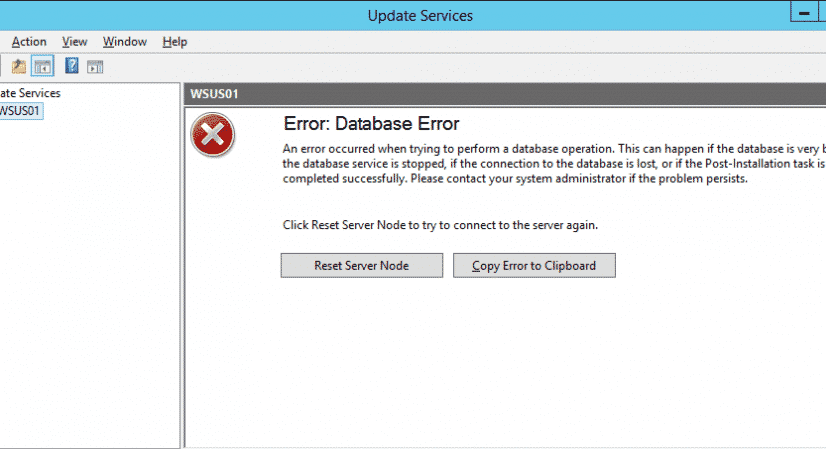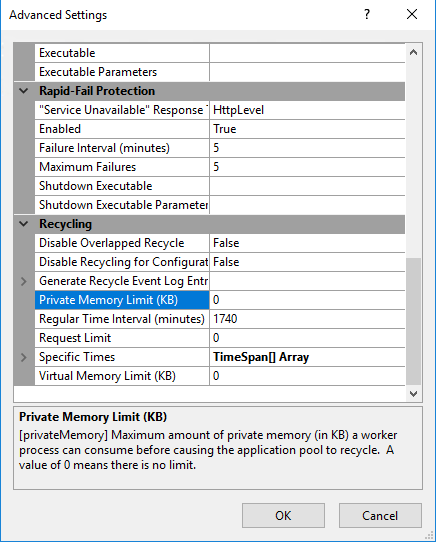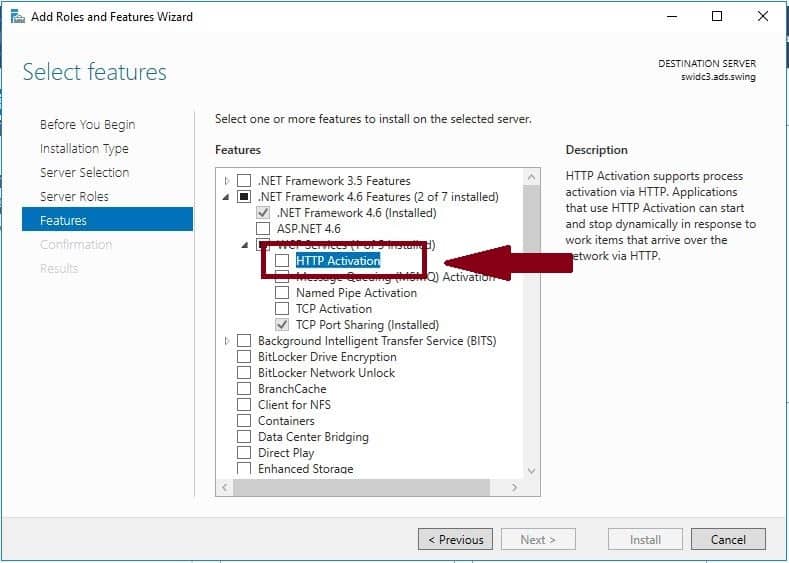WSUS Connection Error
Ich hatte nun des öfteren das Problem, dass es auf einem Server 2016 einen WSUS Connection Error gab. Das sieht dann als Fehlermeldung folgendermaßen aus:
Error: Connection Error
An error occurred trying to connect the WSUS server. This error can happen for a number of reasons. Check connectivity with the server. Please contact your network administrator if the problem persists.
Click reset Server Node to try to connect to the server again.

Dieses Problem hatten bestimmt schon mehrere, und es gibt im Netz unendlich viele Problemlösungen, Fixes, Updates und Möglichkeiten dieses Problem zu beheben. Ich habe euch eine Zusammenfassung der Lösungen zusammengeschrieben 🙂
WSUS Connection Error – Reset Server Node
Bevor wir loslegen, sollten wir mal die Updates aufräumen und die Regeln anwenden:
IIS App Pool anpassen
Bei vielen WSUS Servern hat es geholfen, die Speichernutzung des IIS Application Pool anzupassen. Dafür geht man wie folgt vor:
- Auf den WSUS Server verbinden
- “Internet Information Services Server” (IIS) öffnen
- WSUS Server aufklappen
- “Application Pools” wählen
- Rechtsklick auf “WsusPool“
- “Advanced Settings…”
- Hier ändern wir den Wert “Private Memory Limit” auf “0“
Durch diese Änderung wird die Speichernutzung des WSUS Application Pools nicht limitiert 🙂
Alternativ kann auch z.B. “4000000” für 4 GB verwendet werden – je nach dem 🙂
(Empfehlung)
WSUSUTIL
Um den WSUS Connection Error zu beheben, kann folgendes kleines (mitgeliefertes) Tool benutzt werden. Die wsusutil.exe.
- Auf den Server verbinden
- Eine CMD als Administrator starten
"C:\Program Files\Update Services\Tools\wsusutil.exe" postinstall /servicing
Danach muss noch ein Feature über den Server Manager installiert werden, falls es noch nicht aktiviert ist (bsp. Server 2016)
Zum Schluss einen Server Neustart / Reboot durchführen!
Windows Update / Fix installieren
Microsoft hat anscheinend auch eine Lösung für das Problem gefunden. Es handelt sich um das Update KB4039396. Dieses kann man auch offiziell im Microsoft Update Cataloge herunterladen:
Update herunterladen
Arbeitsspeicher / RAM
Auch wenn von Microsoft nur wenig Arbeitsspeicher angegeben ist, empfehle ich ein wenig mehr CPU und Arbeitsspeicher:
- 2 Cores (CPU)
- 6 GB Arbeitsspeicher
Klar läuft der Server mit weniger auch, allerdings macht es dann wirklich keinen Spaß darauf zu arbeiten 😉
WSUS Datenbank reparieren
Speichert euch folgendes Script als “cleanDB.sql” ab:
/****************************************************************************** This sample T-SQL script performs basic maintenance tasks on SUSDB 1. Identifies indexes that are fragmented and defragments them. For certain tables, a fill-factor is set in order to improve insert performance. Based on MSDN sample at http://msdn2.microsoft.com/en-us/library/ms188917.aspx and tailored for SUSDB requirements 2. Updates potentially out-of-date table statistics. ******************************************************************************/ USE SUSDB; GO SET NOCOUNT ON; -- Rebuild or reorganize indexes based on their fragmentation levels DECLARE @work_to_do TABLE ( objectid int , indexid int , pagedensity float , fragmentation float , numrows int ) DECLARE @objectid int; DECLARE @indexid int; DECLARE @schemaname nvarchar(130); DECLARE @objectname nvarchar(130); DECLARE @indexname nvarchar(130); DECLARE @numrows int DECLARE @density float; DECLARE @fragmentation float; DECLARE @command nvarchar(4000); DECLARE @fillfactorset bit DECLARE @numpages int -- Select indexes that need to be defragmented based on the following -- * Page density is low -- * External fragmentation is high in relation to index size PRINT 'Estimating fragmentation: Begin. ' + convert(nvarchar, getdate(), 121) INSERT @work_to_do SELECT f.object_id , index_id , avg_page_space_used_in_percent , avg_fragmentation_in_percent , record_count FROM sys.dm_db_index_physical_stats (DB_ID(), NULL, NULL , NULL, 'SAMPLED') AS f WHERE (f.avg_page_space_used_in_percent < 85.0 and f.avg_page_space_used_in_percent/100.0 * page_count < page_count - 1) or (f.page_count > 50 and f.avg_fragmentation_in_percent > 15.0) or (f.page_count > 10 and f.avg_fragmentation_in_percent > 80.0) PRINT 'Number of indexes to rebuild: ' + cast(@@ROWCOUNT as nvarchar(20)) PRINT 'Estimating fragmentation: End. ' + convert(nvarchar, getdate(), 121) SELECT @numpages = sum(ps.used_page_count) FROM @work_to_do AS fi INNER JOIN sys.indexes AS i ON fi.objectid = i.object_id and fi.indexid = i.index_id INNER JOIN sys.dm_db_partition_stats AS ps on i.object_id = ps.object_id and i.index_id = ps.index_id -- Declare the cursor for the list of indexes to be processed. DECLARE curIndexes CURSOR FOR SELECT * FROM @work_to_do -- Open the cursor. OPEN curIndexes -- Loop through the indexes WHILE (1=1) BEGIN FETCH NEXT FROM curIndexes INTO @objectid, @indexid, @density, @fragmentation, @numrows; IF @@FETCH_STATUS < 0 BREAK; SELECT @objectname = QUOTENAME(o.name) , @schemaname = QUOTENAME(s.name) FROM sys.objects AS o INNER JOIN sys.schemas as s ON s.schema_id = o.schema_id WHERE o.object_id = @objectid; SELECT @indexname = QUOTENAME(name) , @fillfactorset = CASE fill_factor WHEN 0 THEN 0 ELSE 1 END FROM sys.indexes WHERE object_id = @objectid AND index_id = @indexid; IF ((@density BETWEEN 75.0 AND 85.0) AND @fillfactorset = 1) OR (@fragmentation < 30.0) SET @command = N'ALTER INDEX ' + @indexname + N' ON ' + @schemaname + N'.' + @objectname + N' REORGANIZE'; ELSE IF @numrows >= 5000 AND @fillfactorset = 0 SET @command = N'ALTER INDEX ' + @indexname + N' ON ' + @schemaname + N'.' + @objectname + N' REBUILD WITH (FILLFACTOR = 90)'; ELSE SET @command = N'ALTER INDEX ' + @indexname + N' ON ' + @schemaname + N'.' + @objectname + N' REBUILD'; PRINT convert(nvarchar, getdate(), 121) + N' Executing: ' + @command; EXEC (@command); PRINT convert(nvarchar, getdate(), 121) + N' Done.'; END -- Close and deallocate the cursor. CLOSE curIndexes; DEALLOCATE curIndexes; IF EXISTS (SELECT * FROM @work_to_do) BEGIN PRINT 'Estimated number of pages in fragmented indexes: ' + cast(@numpages as nvarchar(20)) SELECT @numpages = @numpages - sum(ps.used_page_count) FROM @work_to_do AS fi INNER JOIN sys.indexes AS i ON fi.objectid = i.object_id and fi.indexid = i.index_id INNER JOIN sys.dm_db_partition_stats AS ps on i.object_id = ps.object_id and i.index_id = ps.index_id PRINT 'Estimated number of pages freed: ' + cast(@numpages as nvarchar(20)) END GO --Update all statistics PRINT 'Updating all statistics.' + convert(nvarchar, getdate(), 121) EXEC sp_updatestats PRINT 'Done updating statistics.' + convert(nvarchar, getdate(), 121) GO
Nun Verbindet ihr euch auf den WSUS und Startet PowerShell mit Administrator Rechten.
Mit folgendem Befehl startet ihr das SQL Script auf der WSUS Datenbank:
sqlcmd -I -S \\.\pipe\MICROSOFT##WID\tsql\query -i C:\cleanDB.sql
Dan ganze kann bis zu einer Stunde dauern, also nicht erschrecken, wenn es lange dauert 😉




